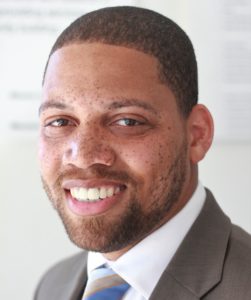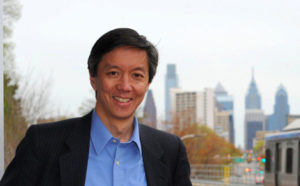What has COVID-19 shown us about gaps in poverty alleviation? A look at South Philly
 December 15, 2020
Category: Featured, Long, Purpose
December 15, 2020
Category: Featured, Long, Purpose
For Otis Bullock, executive director of Diversified Community Services (DCS), a 100+ employee community-based organization, COVID revealed how much the services DCS provides are reliant on face-to-face interactions.
DCS offers varied services, including early childhood education, an afterschool program, housing counseling, and commercial corridor work on Point Breeze Avenue, Snyder Avenue, and Passayunk Avenue. When COVID-19 hit and everything shut down, Bullock said there was a big communication gap over how to respond to this crisis, provide services, and communicate with clients when so much was reliant on face-to-face communication and foot traffic in the neighborhood.
DCS realized that they didn’t have another way of communicating with their businesses on the corridor after they shut down.
A lot of grassroots organizations faced the same challenge.
To address this gap, DCS had to expand its partnerships. The organization works more closely with the Southeast Asian Mutual Assistance Association Coalition (SEAMAAC) now. “We have a real language gap in South Philly, with the Southeast Asian community,” Bullock said. “We realized that we had to have a more robust partnership with SEAMAAC to reach that community in a deeper way.”
DCS is working with SEAMAAC on expanding it service area, incorporating the other nonprofit into how they provide their services, particularly around language and translation services. And, Bullock said, DCS has had to pivot.
“How do we provide services virtually and remotely and make up for the technology gap that exists in our community? We’re still working on that now,” he said.
DCS is developing new marketing materials, for example. Typically, DCS markets with flyers and hard copy material. They are not going to stop doing that, but they are about to embark on a mail campaign with a difference.
“We are adding a QR code that is going to be on every piece of material that we have,” Bullock said. “Most people have smart phones. With the QR code, people can go online and access our services.”
Andy Toy, director of community development at SEAMAAC, said they are relieving the symptoms of poverty as much as they can.
“Unfortunately, we’re not treating everything (the causes), but rather the symptoms,” he said. “We’ve pivoted hard to do a lot of hunger relief work. We’re doing a food distribution in a very large way right now.”
“We’re part of Step Up to the Plate, a meal distribution program four days a week,” Toy added. “We’re working with Share Foods, giving out food boxes, also delivering food to shut-in elders, mainly immigrant refugee elders. It’s around 60 or 70 boxes a week now.”
SEAMAAC held elders’ gatherings in the past but now, Toy said, “We’re just delivering food to them because they can’t come and gather anymore at this point, not for a while.”
He said that SEAMAAC’s immediate responses sought to meet the needs prompted by the pandemic. “A lot of people are not working, and a lot of people are struggling to basically just survive,” he said. “It goes beyond the Asian American communities and the immigrant communities. It’s widespread, unfortunately right now.”
The organization has a staff of about 50 people. Its core programs — education, truancy case management and afterschool programming — are difficult right now with the pandemic because everything virtual. SEAMAAC also does a lot of virtual health and social services work, including ESL classes, helping people to get benefits, helping people with language access and healthcare.
SEAMAAC partnered with Jefferson University Hospital to create a wellness center which will be up and running by late January of 2021 at the Bok Building.
“We’re really excited about that,” Toy said. “We’ll be co-locating our outreach workers who are fluent in many languages there. One of the great assets of SEAMAAC is that we have people that speak probably 19 languages on staff.”
Toy runs the community development arm of SEAMAAC which has a neighborhood plan for Mifflin Square Park, a big park in South Philly below Snyder. They’re also working with the businesses on South Seventh Street to help them survive the pandemic.
Nevi Widiyastuty is a local resident, originally from Indonesia, who has benefited from SEAMAAC’s services over the past several years. A domestic violence survivor, Widiyastuty lives with three children ages 16, 14 and 9.
She said SEAMAAC has been a lifeline to them — helping her apply for benefits and assisting her family financially and with needed food donations.
Another South Philly resident who has relied on SEAMAAC services is 47-year-old Ani Fari, also and Indonesian immigrant. Fari has not been working for the past few weeks due to COVID-19. She had a mild case of COVID, but she had to quarantine and missed work.
Fari’s 50-year-old husband has HIV and a weakened immune system, and she was concerned he would also contract COVID. For several weeks, they slept in different rooms as they quarantined. Last Thursday, she was relieved to test negative for COVID, but she still worries about her husband getting the virus.
Several weeks ago, Evelyn, a woman who works for SEAMAAC and attends the same church as Fari — Philadelphia Presenter on 17th and McKean — reached out to help the couple. The organization was able to give them $500 to assist with household bills.
Francis Carney, executive director at United Communities Southeast Philadelphia, said one of the biggest impacts they have seen is the lack of technology access; sometimes it is not even access, but it’s comprehension when you add in language barriers.
Most of the work the organization does is housing counseling, rental assistance, and benefits access work. The benefits access work has remained active, although not at the level it was pre-COVID.
About 400 people were approved for benefits at Houston Center during the past year — benefits that they were not getting before, that they did not know that they were eligible for.
“We have not had walk-in hours at our center, and we don’t right now,” Carney said. “And even where we have had that they’ve been limited. But we have tried to have as many of our services as possible be virtual.”
He said there really is an access gap: “While we could use Language Line, or do some other things to have conversations with people, there still are challenges in making sure that the population immediately surrounding the Houston Center on Eighth and Snyder is able to access all of the services that we have via technology (virtually).”
Since United Communities does not have walk-in hours and they are doing things virtually, Carney said they’re probably only seeing about 20% of what they were seeing before on a regular basis.
United Communities is trying to make sure that people are aware of benefits that they may be entitled to and providing opportunities for them to set up appointments. They do that virtually with people via a FaceTime call or over Zoom, and then planning so that if they need to drop off paperwork, they’re clear about what they need to bring to the center so that the staff can file the applications on their behalf.
"There still are challenges in making sure that the population immediately surrounding the Houston Center on Eighth and Snyder is able to access all of the services that we have via technology."
Carney currently has two staff members that are benefits access counselors and three staff that are housing counselors (there’s some crossovers in the work that they do). Their work is primarily focused on the traditional federal benefits map, and rental rebates. Now housing staff is focused specifically on issues related to shelter, and the organization has a housing counselor who is participating in the rental court that has been started since the pandemic began.
They used to see primarily those who knew about organization from word-of-mouth or who were referred to them from other organizations, but Carney said they are starting to see some referrals come through the Department of Health and from some healthcare providers.
“The Health Federation connected with our team so that there’s information about particular benefits access in our housing counseling work,” Carney said. “If people are going into a variety of healthcare centers — CHOP, University of Pennsylvania Hospital and Jefferson, they may be referred to us.”
“We’re looking to connect more with the healthcare sector,” he added, “as there’s been some movement in that sector to make sure that they’re connecting more with community-based organizations.”
Project
Poverty Action seriesTrending News












